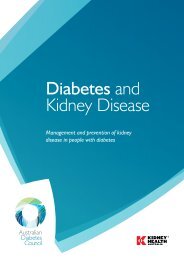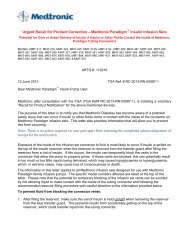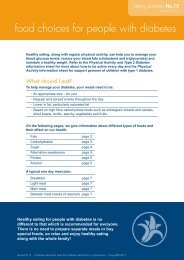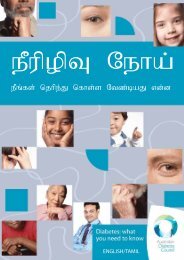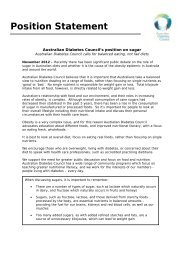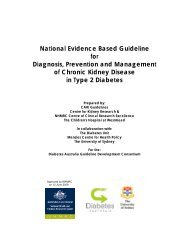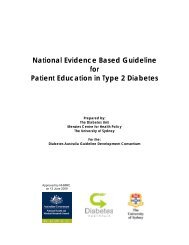O MeA e tAtAU OnA e IlOA - Australian Diabetes Council
O MeA e tAtAU OnA e IlOA - Australian Diabetes Council
O MeA e tAtAU OnA e IlOA - Australian Diabetes Council
Create successful ePaper yourself
Turn your PDF publications into a flip-book with our unique Google optimized e-Paper software.
Types of diabetes - continued<br />
Type 2 diabetes<br />
This type of diabetes is usually diagnosed in people over 40 years of age. However it is now<br />
being diagnosed in younger people, including children. Poor lifestyle choices are a major<br />
reason for this increase in young people .<br />
Inactivity and poor food choices can result in weight gain, especially around the waist.<br />
This prevents the body from being able to use insulin properly (insulin resistance) so blood<br />
glucose levels rise. Type 2 diabetes has a slow onset.<br />
Type 2 diabetes runs in families so children and grandchildren are at risk. The good news is<br />
that type 2 diabetes can be delayed or prevented when healthy lifestyle choices that focus<br />
on increasing physical activity, healthy food choices and weight loss are made. For this reason<br />
it is important to know your risk for type 2 diabetes.<br />
Symptoms of type 2 diabetes may include frequent urination, thirst, blurred vision, skin<br />
infections, slow healing, tingling and numbness in the feet. Often, there are no symptoms<br />
present, or symptoms are not recognised.<br />
Once diagnosed, it is very important to maintain good blood glucose (sugar) levels as soon<br />
as possible to avoid complications.<br />
Management should begin with healthy food choices and regular physical activity. However,<br />
diabetes is a progressive disease and over time, oral medications and/or insulin may be needed.<br />
12




